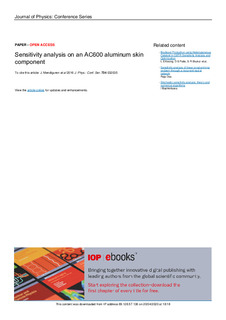Título
Sensitivity analysis on an AC600 aluminum skin componentFecha de publicación
2016Versión
Version publicadaTipo de documento
Contribución a congresoContribución a congresoIdioma
InglésAcceso
Acceso abiertoVersión de la editorial
http://dx.doi.org/10.1088/1742-6596/734/3/032035Publicado en
Journal of Physics: Conference Series Vol. 734. N. artículo 032035, 2016Editorial
IOPPalabras clave
Aluminum
Aluminum alloys
Anisotropy
Drawing (forming) ... [+]
Aluminum alloys
Anisotropy
Drawing (forming) ... [+]
Aluminum
Aluminum alloys
Anisotropy
Drawing (forming)
Friction
Hardening
High strength steel
Manufacture
Metal drawing
Metal forming
Numerical models
Sheet metal [-]
Aluminum alloys
Anisotropy
Drawing (forming)
Friction
Hardening
High strength steel
Manufacture
Metal drawing
Metal forming
Numerical models
Sheet metal [-]
Resumen
New materials are been introduced on the car body in order to reduce weight and fulfil the international CO2 emission regulations. Among them, the application of aluminum alloys is increasing for ski ... [+]
New materials are been introduced on the car body in order to reduce weight and fulfil the international CO2 emission regulations. Among them, the application of aluminum alloys is increasing for skin panels. Even if these alloys are beneficial for the car design, the manufacturing of these components become more complex. In this regard, numerical simulations have become a necessary tool for die designers. There are multiple factors affecting the accuracy of these simulations e.g. hardening, anisotropy, lubrication, elastic behavior. Numerous studies have been conducted in the last years on high strength steels component stamping and on developing new anisotropic models for aluminum cup drawings. However, the impact of the correct modelling on the latest aluminums for the manufacturing of skin panels has been not yet analyzed. In this work, first, the new AC600 aluminum alloy of JLR-Novelis is characterized for anisotropy, kinematic hardening, friction coefficient, elastic behavior. Next, a sensitivity analysis is conducted on the simulation of a U channel(with drawbeads). Then, the numerical an experimental results are correlated in terms of springback and failure. Finally, some conclusions are drawn. [-]
Colecciones
- Congresos - Ingeniería [435]
El ítem tiene asociados los siguientes ficheros de licencia:






















